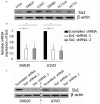Targeting Six1 by lentivirus-mediated RNA interference inhibits colorectal cancer cell growth and invasion
- PMID: 24551283
- PMCID: PMC3925907
Targeting Six1 by lentivirus-mediated RNA interference inhibits colorectal cancer cell growth and invasion
Abstract
The Six1 homeodomain protein is a developmental transcription factor that has been implicated in tumor onset and progression. Recently, it's reported that overexpression of Six1 is sufficient to induce epithelial-to-mesenchymal transition (EMT) and metastasis of colorectal cancer. Moreover, its expression is significantly associated with poorer overall survival probability in advanced-stage colorectal cancer. To address whether Six1 could serve as a therapeutic target for human colorectal cancer, we used a lentivirus-mediated short hairpin RNA (shRNA) gene knockdown method to suppress the expression of Six1 in colorectal cancer cells. We showed that lentivirusmediated shRNA targeted to Six1 gene efficiently reduced its expression in colorectal cancer cells at both mRNA and protein levels. In vitro functional assays revealed that knockdown of Six1 significantly suppressed cell proliferation, and inhibited cell migration and invasion of colorectal cancer cells. Furthermore, tumor xenograft model demonstrated that downregulation of Six1 dramatically inhibited colorectal cancer growth in vivo. In conclusion, these findings suggest that lentivirus-mediated Six1 inhibition may represent a novel therapeutic approach for treatment of colorectal cancer.
Keywords: Six1; cell growth; colorectal cancer; invasion.
Figures




Similar articles
-
Lentivirus-mediated RNAi knockdown of VEGFA in RKO colorectal cancer cells decreases tumor formation and growth in vitro and in vivo.Int J Clin Exp Pathol. 2012;5(4):290-8. Epub 2011 Apr 30. Int J Clin Exp Pathol. 2012. PMID: 22670172 Free PMC article.
-
[Silencing HMGB1 expression by lentivirus-mediated small interfering RNA (siRNA) inhibits the proliferation and invasion of colorectal cancer LoVo cells in vitro and in vivo].Zhonghua Zhong Liu Za Zhi. 2015 Sep;37(9):664-70. Zhonghua Zhong Liu Za Zhi. 2015. PMID: 26813430 Chinese.
-
NOB1 is essential for the survival of RKO colorectal cancer cells.World J Gastroenterol. 2015 Jan 21;21(3):868-77. doi: 10.3748/wjg.v21.i3.868. World J Gastroenterol. 2015. PMID: 25624720 Free PMC article.
-
The role of homeobox gene Six1 in cancer progression and its potential as a therapeutic target: A review.Int J Biol Macromol. 2025 May;308(Pt 4):142666. doi: 10.1016/j.ijbiomac.2025.142666. Epub 2025 Mar 29. Int J Biol Macromol. 2025. PMID: 40164243 Review.
-
SIX1 transcription factor: A review of cellular functions and regulatory dynamics.Int J Biol Macromol. 2021 Dec 15;193(Pt B):1151-1164. doi: 10.1016/j.ijbiomac.2021.10.133. Epub 2021 Nov 3. Int J Biol Macromol. 2021. PMID: 34742853 Review.
Cited by
-
Six1 promotes colorectal cancer growth and metastasis by stimulating angiogenesis and recruiting tumor-associated macrophages.Carcinogenesis. 2017 Mar 1;38(3):281-292. doi: 10.1093/carcin/bgw121. Carcinogenesis. 2017. PMID: 28199476 Free PMC article.
-
SIX1 Predicts Poor Prognosis and Facilitates the Progression of Non-small Lung Cancer via Activating the Notch Signaling Pathway.J Cancer. 2022 Jan 1;13(2):527-540. doi: 10.7150/jca.61385. eCollection 2022. J Cancer. 2022. PMID: 35069900 Free PMC article.
-
Targeting sine oculis homeoprotein 1 (SIX1): A review of oncogenic roles and potential natural product therapeutics.Heliyon. 2024 Jun 17;10(12):e33204. doi: 10.1016/j.heliyon.2024.e33204. eCollection 2024 Jun 30. Heliyon. 2024. PMID: 39022099 Free PMC article. Review.
-
Proteogenomic analysis reveals exosomes are more oncogenic than ectosomes.Oncotarget. 2015 Jun 20;6(17):15375-96. doi: 10.18632/oncotarget.3801. Oncotarget. 2015. PMID: 25944692 Free PMC article.
-
Sine oculis homeobox 1 promotes proliferation and migration of human colorectal cancer cells through activation of Wnt/β-catenin signaling.Cancer Sci. 2019 Feb;110(2):608-616. doi: 10.1111/cas.13905. Epub 2019 Jan 28. Cancer Sci. 2019. PMID: 30548112 Free PMC article.
References
-
- Huerta S. Recent advances in the molecular diagnosis and prognosis of colorectal cancer. Expert Rev Mol Diagn. 2008;8:277–288. - PubMed
-
- Siegel R, Ward E, Brawley O, Jemal A. Cancer statistics, 2011: the impact of eliminating socioeconomic and racial disparities on premature cancer deaths. CA Cancer J Clin. 2011;61:212–236. - PubMed
-
- Chua YJ, Zalcberg JR. Progress and challenges in the adjuvant treatment of stage II and III colon cancers. Expert Rev Anticancer Ther. 2008;8:595–604. - PubMed
-
- Christensen KL, Patrick AN, McCoy EL, Ford HL. The six family of homeobox genes in development and cancer. Adv Cancer Res. 2008;101:93–126. - PubMed
Publication types
MeSH terms
Substances
LinkOut - more resources
Full Text Sources
Other Literature Sources
Medical
